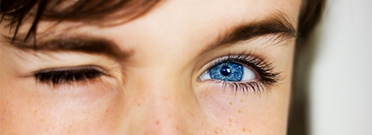What Can Happen In the Blink of an Eye

By Iva Fedorka
Sighted people miss about a fifth of a second of vision every time they blink. Those 200 milliseconds may not seem like much, but when you’re driving a car at 200 miles an hour, you could miss seeing 66 feet of track every time you close your eyes!
What Is Blinking?
Blinking is a semi-autonomic action that takes place an average of 15 to 17 times per minute in humans. A blink cleans the surface of the eye and produces a stable tear film that helps maintain clear vision.
But blinking also interrupts one’s sight every 3 to 4 seconds. A person’s blink rate is controlled by a combination of vision maintenance, cognitive state, psychological factors, and medical conditions.
When not timed correctly, blinking can lead to negative outcomes. For example, human micro expressions, or transient facial movements that reflect one’s true feelings, last for only 160 to 500 microseconds and could be completely missed during a blink. To minimize any negative effects, many people temporarily modify or suppress their blinking, but it’s difficult to measure those changes and their impact.
Do Blinking Patterns Change While Driving?
Although people typically blink at random intervals, a recent study published in iScience by cognitive neuroscientist Ryota Nishizono and colleagues found that isn’t always true. A former professional cyclist, Nishizono was inspired by the lack of articles and studies about blinking behavior during cycling or motor racing and decided to investigate the topic himself.
For the experiment, eye trackers were mounted on the helmets of three Formula One drivers. The racers then completed a total of 304 laps on three Formula One circuits: the Fuji Speedway, the Suzuka International Racing Course, and Sportsland SUGO.
The drivers’ blinking patterns were unexpectedly predictable. They avoided blinking when maneuvering curves or changing speed or direction and blinked more often and consistently on straight sections of the tracks.
Findings and Future Studies
The results highlight the trade-off between keeping our eyes moist and maintaining vision during crucial tasks. Nishizono’s group identified three underlying factors for blink patterns: one’s personal blink count, the lap pace and how closely it was replicated, and the acceleration associated with comfortable blinking. Their findings also suggest that blinking is correlated with one’s changing cognitive state.
Blinking patterns while driving may be more obvious than those observed during passive tasks. Other factors like driver expertise, knowledge of the courses, the risk of fatality while driving, sensory information intensity, and active motor control also contribute but were not separately assessed in this experiment.
Next, Nishizono wants to further explore the processes that allow or inhibit blinking and how blinking behavior varies among the general population.
Discussion Questions
- Can you think of other situations where changes in blinking patterns might be significant?
- What other everyday activities can be affected by stress?
